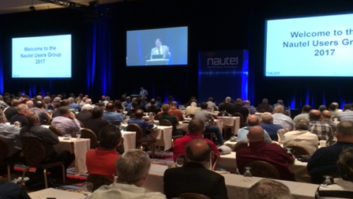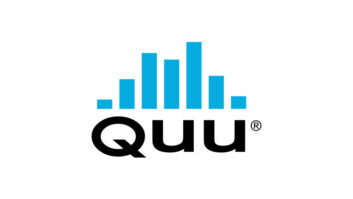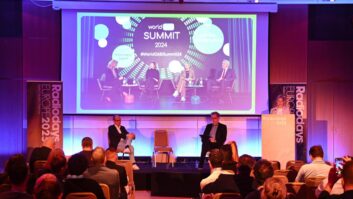AM revitalization and NextRadio improvements carry the hopes of many in the radio industry as managers and engineers ponder how to reinvent the medium to keep up with competitors online and elsewhere.
These topics were major themes at the recent fall Radio Show in Indianapolis. NextRadio proponents touted improvements to the FM cellphone app; their partnership with Sprint is now a year old. On the senior band, owners of struggling AM properties await the commission’s action to ease restrictions and give relief. Some of those hopes were disappointed after the show, when the FCC denied an FM translator request that had been pending for two years (see story below).
The evolving, multiplatform nature of the medium was reflected after the convention when Clear Channel Media & Entertainment changed its name to iHeartMedia. Chair/Chief Executive Officer Bob Pittman believes the moniker, playing off the company’s successful iHeartRadio brand, will resonate better with advertisers than the legacy term “clear channel.”
Radio Show organizers estimated attendance at 2,100 compared to 2,300 last year in Orlando. Next year’s Radio Show will be in Atlanta.
Here is a final wrap of news highlights from the convention and immediately after. We’ll cover news about HD Radio, including all-digital AM tests, in a subsequent article.

Chairman/President/CEO Jeff Smulyan, left, with Paul Brenner and Ben Husmann, called the NextRadio update “a major breakthrough.”
Credit:
© Radio Show GEN 2 NEXTRADIO APP UNVEILED
Emmis unveiled the next generation of the NextRadio FM smartphone app. Chairman/President/CEO Jeff Smulyan calls the update “a major breakthrough.”
NextRadio provides local FM listening via certain smartphones that have FM chips enabled. Depending on station participation, listeners can also get station branding and interactivity.
In the new version, LiveGuide is a visual tuning interface that displays local radio stations by real-time album art or custom schedule content; it’s one of several improvements to the app.
With LiveGuide, listeners can turn on the radio and see what’s playing on all local stations at once. Listeners can see their favorite song, click on it and hear the broadcast.
Emmis Chief Technical Officer Paul Brenner says the changes make for “a really simple approach. We needed to make it easier for the listener” to use.
Another change is a streamlined navigation “drawer” that puts all user options on one place. In-app tutorials show listeners how to interact with local stations, “a behavior change that can grow radio’s position in the expanding mobile ad business,” according to Emmis.
NextRadio and iBiquity also are working together on an integrated automotive platform; we’ll have details in the next issue. And broadcast software company RCS, which is part of iHeartMedia (the former Clear Channel), announced support for TagStation within its automation systems.
According to the latest figures, 10,400 FM stations had been tuned to using the NextRadio app as of mid-September. Emmis says some 6,700 stations are represented graphically in the app; 1,500 of those provide interactivity while the rest provide basic station logos.

A super session on hybrid radio featured, from left, moderator Jeff Simpson, board member at DMC-Bonneville; Eric Williams, product manager at Sprint Communications; Ginny Morris, chairman and chief executive officer of Hubbard Radio Group; Dave Kelly, researcher for Big Machine Label Group; and Paul Brenner, chief technical officer at Emmis Communications.
Credit:
© Radio Show WILL OTHER CARRIERS INCORPORATE APP?
Some 7 million smartphones have been sold with the NextRadio FM app enabled. But Emmis gets a lot of questions about when carriers other than Sprint will incorporate the NextRadio FM app in their devices.
Chief Technical Officer Paul Brenner says carriers worry about radio delivering consistent product in a unified way: “Their hesitation is radio can’t do it.”
Eric Williams, product manager for Sprint, said, “When you can say the whole industry is behind this, that’s when it’s going to happen.” The larger carriers are asking if NextRadio is “fully functional and is everybody participating.”
Brenner said the company has been able to secure meetings with larger carriers that “we could not get two years ago” because of the app’s growth.
Further, NAB is looking at ideas to help market NextRadio, according to Brenner.
Williams says the data Sprint sees about what users do with the app is insightful. “We monitor every category. There’s 17 to 20 percent growth month over month.” Using the data, Sprint can see metrics such as a user’s education level and where they shop. “It’s powerful, what you can do with it.”
RAB President and Chief Executive Officer Erica Farber said she travels a lot and has visited many Sprint stores in the past 12 months. There was “not one store that didn’t know” what she was talking about when she asked salespeople about the NextRadio app.

Cumulus Media CEO Lew Dickey said of the NextRadio app: “If we can have FM on every cellphone, we will have more consumption of our medium.”
Credit:
© Radio Show FM CHIP EXPANSION?
The NextRadio app relies on an activated FM chip in the smartphone; and Emmis Communications Chair/President/Chief Executive Officer Jeff Smulyan sounded optimistic that more carriers will activate those chips, as many in radio have hoped.
“We think we’re getting closer” to that, Smulyan said during a discussion with radio group executives. “We think we’re close to a tipping point.” But he downplayed a suggestion that the industry should try again to get Congress to enact a mandate.
Some 27 Sprint smartphone models now come preloaded with the NextRadio app; that figure includes HTC smartphones on major wireless carrier networks. AT&T and Verizon “didn’t turn it off,” meaning disable the FM chip in those HTC phones, according to Smulyan.
He said automakers, too, are asking about the NextRadio app. “Our challenge is to drive home the message to our listeners.”
Cumulus CEO Lew Dickey said of the app, “If we can have FM on every cellphone, we will have more consumption of our medium.” A :30- or :60-second ad “is just as valuable on a cellphone if I listen to it in my car.”
Dean Goodman, president and founder of radio group Digity, called for an FM chip mandate, noting the emergency alerting capabilities of the chip. “How many times does there need to be a disaster to prove what this industry does?”
Smulyan said the industry earlier had “decided … not to go for a mandate,” but he acknowledged that some members of Congress are asking why all smartphone models in the U.S. don’t include an FM chip. He said he would leave it in NAB’s hands whether to press for a mandate.
Asked about the possibility of reviving interest in a mandate, NAB spokesman Dennis Wharton told Radio World: “From a public safety perspective and because radio is a lifeline in times of crisis, we believe cell carriers should voluntarily activate FM chips already in the phones.”
In a separate session, NAB President/CEO Gordon Smith asked FCC Commissioner Ajit Pai about the concept of persuading more carriers to activate or integrate FM chips on smartphones. Smith asked Pai if he has ways to nudge the carriers in this regard.

NAB President/CEO Gordon Smith, left, asked FCC Commissioner Ajit Pai about persuading more carriers to activate or integrate FM chips on smartphones.
Credit:
© Radio Show Pai has seen demos of the NextRadio app, and said: “As a consumer, I would love to have that functionality. To be able to listen to an FM broadcast over the phone would be tremendous.”
He cautioned, however, that a mandate would be “difficult” for the commission in terms of whether the agency has the legal authority to compel wireless carriers to activate embedded FM chips and whether a mandate effort would be successful in the long run.
“I’ve got to think consumer demand would eventually persuade them to default to activate the chip,” said Pai. “Peer pressure is a powerful thing.” The commissioner pledged to continue to nudge his own carrier, which he did not name, and to “speak for” the issue generally.
HANSON DUBIOUS ON NEXTRADIO
While many broadcasters believe the NextRadio FM app on smartphones and eventually the dashboard is a good way to keep radio relevant and provide interactivity to listeners, not everyone is a believer.
RAIN Publisher Kurt Hanson, who has an ownership stake in online pioneer AccuRadio, says NextRadio has to be looked at “with a dispassionate eye” and see how it does in a year.
According to the latest Emmis information, there have been some 915,000 downloads of the NextRadio FM app. Hanson studied data about the first 750,000 downloads and says the average user listens for a total of 80 minutes and then stops. Emmis officials disputed that conclusion in an interview with Radio World.
Speaking at the RAIN conference, Hanson said the name NextRadio is inaccurate because it’s really an “easier way to get the previous generation of radio.”
Consultant Mark Ramsey of Mark Ramsey Media also has been critical of the technology and of its promotion. He blogged recently that while NextRadio use is “modestly” growing, “Your own radio station’s web stream is likely serving more listeners right now than the entire NextRadio platform at the same time.”
EAS TEST RESULTS LOOK GOOD
Early indications are the EAS test in West Virginia that took place shortly after the show went well. The Sept. 17 event was the first statewide test of CAP-EAS and of the NPT event header code.
The U.S. Department of Homeland Security’s Federal Emergency Management Agency, the West Virginia Division of Homeland Security and Emergency Management, the West Virginia Broadcasters Association and others were involved.
FEMA originated a Common Alerting Protocol-EAS message with a “National Periodic Test” event code and uploaded that at 2 p.m. (EST) Sept. 17 to its Integrated Public Alert and Warning System OPEN servers. EAS encoders/decoders of stations in West Virginia polled the IPAWS EAS “Atom” feed, downloaded the message file that contained an audio file and aired it.
FEMA had also asked the stations to configure their EAS devices so the test could immediately be fed to other stations down the daisy chain.
Knowledgeable sources said early results indicate the test went well, though those involved expected to continue gathering information for several weeks.
West Virginia Broadcast Association Executive Director Michele Crist told Radio World she’s heard from some 130 radio and TV stations that received and aired the test. Most of the stations were able to retransmit the alert message, she said, but a “handful” could not retransmit it because they hadn’t configured their EAS encoders/decoders correctly.
Overall, “people said their signal was good,” she said. From her office in the state capital Charleston, Crist said she monitored the test on several stations and it looked and sounded “liked a normal EAS test.”
As RW has reported, FEMA added the word “national” to the familiar beginning: “This is a test of the national emergency alert system.”
FEMA will take the information gleaned from the test and add it to its knowledge base in preparation for a national EAS test in 2015. The 2011 national EAS test used the legacy system and not CAP.
The test included radio, television and cable systems as part of the regular monthly EAS conducted by West Virginia broadcasters. FEMA also monitored message dissemination through wireless emergency alerts.
Authorities chose West Virginia for the Sept. 17 limited test because of its challenges, according to FEMA IPAWS Project Manager Al Kenyon. He told attendees of the Radio Show that many people in the state live in valleys, where signal reception is difficult to obtain. The national radio quiet zone is also located in West Virginia. Yet the state also has a high number of counties, some 47 out of 55, that have registered to participate in EAS; the others are in-process, according to Kenyon.

At the fall Radio Show, FEMA IPAWS Project Manager Al Kenyon previewed the EAS test in West Virginia. FCC Audio Division Chief Peter Doyle told broadcasters that waiver applications related to radio licenses will be harder to obtain.
Credit:
Photo by Jim Peck TECHNICAL WAIVERS TIGHTENED
In order to reduce a backlog of radio applications that have languished at the commission for many years, the Media Bureau is trying to streamline its paperwork procedures and “commoditize” the process, according to Audio Division Chief Peter Doyle.
The division acts on 10,000 cases each year. Chairman Tom Wheeler “has put resources and energy behind trying to tackle what’s been a serious backlog,” Doyle said. He estimates there will be cases “in the double-digits” ready to be finalized by the Oct. 30 FCC meeting.
“As we try to commoditize” the application review process, “we’re going to be more rigorous when considering waivers,” he said. “The bad news I’m bringing you … is you’re not special. If hundreds of people can make the same argument, it’s just not going to fly with us anymore,” Doyle said, referencing that some broadcasters cite mountains in California or Colorado as justification for a particular waiver. “If the rules don’t work for you then a [petition for a] rulemaking is the way to go,” he said.
He asked broadcast attorneys to rethink the current “hyper-litigious culture” that led to the backlog.
NAB/RAB WARN ABOUT SCAM
The NAB and RAB alerted attendees about a scam just after the Indianapolis event ended.
The organizations said an unaffiliated third party, which they did not name, was contacting attendees with an offer to sell the Radio Show attendee contact list. The unnamed company had some, but not all, attendee email and phone numbers, NAB told Radio World.
NAB and RAB say they have not given any information to this group, “nor have they received permission from us to sell or distribute such information,” they told attendees in an email. “The disclaimer on the bottom of their promotion states that the information was ‘… acquired by tele-calling and email campaigning …’ by the group.”
Per their privacy policy, RAB and NAB say they do not sell email addresses or phone numbers, and they generally don’t share their attendee contact information, “except when asked to do so by law, regulation or government request, or on a restricted basis with contractors fulfilling obligations directly related to NAB/RAB activities.”







